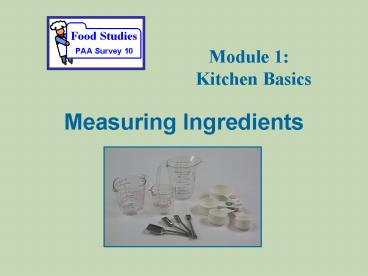Measuring Ingredients - PowerPoint PPT Presentation
1 / 30
Title:
Measuring Ingredients
Description:
Spoon the flour into the dry measure measuring cup, filling to overflowing. ... Overfill the measuring spoon and level off the dry ingredient with a straight ... – PowerPoint PPT presentation
Number of Views:2377
Avg rating:5.0/5.0
Title: Measuring Ingredients
1
Measuring Ingredients
Module 1 Kitchen Basics
2
Measuring Ingredients Introduction
- To produce quality cooked and baked products, it
is important to measure the ingredients
accurately.
Beginning cooks are advised to make the effort
to measure accurately moreexperienced cooks are
often able to use more approximate measures for
some recipes without affecting product quality.
3
Measuring Ingredients Equipment
- Choosing the correct measuring equipment is the
first step in making accurate measurements.
The choice of which type of measuring equipment
to use depends upon the types and amounts of
ingredients that will be measured.
4
Measuring Ingredients Equipment
- Dry ingredients, such as flour and sugar, are
measured in plastic or metal measuring cups.
5
Measuring Ingredients Equipment
Dry measure measuring cups are designed to allow
the cook to fill the cup to overflowing then
level the ingredient off with a straight-edged
utensil.
6
Measuring Ingredients Equipment
7
Measuring Ingredients Equipment
8
Measuring Ingredients Equipment
Dry and liquid ingredients and fats may be
measured using measuring spoons.
9
Measuring Ingredients Equipment
Measuring equipment may provide
Metric measures,
Imperial measures,
or both.
10
Measuring Ingredients
- How to Measure Dry Ingredients
11
How to Measure Dry Ingredients
Flour
Because flour may settle and pack during shipping
and storage, stir the flour in its container
before you measure.
If the recipe calls for sifted flour, spoon the
stirred flour into the sifter, sift the flour and
then measure it.
12
How to Measure Dry Ingredients
Flour
13
How to Measure Dry Ingredients
Granulated Sugar
Granulated (white) sugar does not pack, so no
stirring is required before measuring.
14
How to Measure Dry Ingredients
Brown Sugar
Brown sugar should be firmly packed into the dry
measure measuring cup.
15
How to Measure Dry Ingredients
Small Amounts
When small amounts of a dry ingredient, such as
flour, sugar, baking powder, baking soda, salt
and spices, are to be measured, measuring spoons
are used.
16
Measuring Ingredients
- How to Measure Liquid Ingredients
17
How to Measure Liquid Ingredients
Measuring cups for liquid ingredients must be
placed on a level surface when measuring. Avoid
lifting the cup to read the measure as it will
probably tilt causing you to read an inaccurate
amount.
18
How to Measure Liquid Ingredients
Once the measuring cup is on a level surface add
the liquid you wish to measure.
19
How to Measure Liquid Ingredients
Small Amounts
20
How to Measure Fats
Oil
21
How to Measure Fats
Solid Fats
Solid fats include butter, margarine, lard and
shortening.
Several methods of measurement may be used for
solid fats, depending upon what kind of fat you
will be measuring and how much fat you need to
measure.
22
How to Measure Fats
Soft Solid Fats
23
How to Measure Fats
Firm Solid Fats
Firm fats, such as lard, shortening, cold butter
and baking margarine, may be cut from the block,
if the package provides measurements for doing
so.
24
How to Measure Fats
Firm Solid Fats
25
How to Measure Fats
Firm Solid Fats
Firm fats may also be measured by water
displacement.
Select a liquid measure measuring cup which could
hold at least twice the amount of fat to be
measured.
26
How to Measure Fats
Firm Solid Fats
27
How to Measure Fats
Firm Solid Fats
28
How to Measure Fats
Firm Solid Fats
Pour off the water then use the fat as required.
29
Measuring Ingredients Conclusion
- Accurate ingredient measurement is an important
part of creating a quality food product.
With practise, every cook can develop accurate
measuring skills.
30
The End































